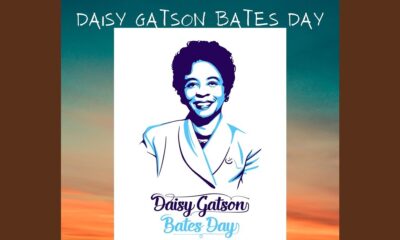Festivals & Events
Interesting Facts about Daisy Bates You Should Need to Know on Daisy Gatson Bates Day

Daisy Gatson Bates Day celebrates the life of the civil rights activist who, in 1957, played a key role in resolving an integration crisis at Little Rock Central High School. In addition to Washington’s Birthday, the third Monday of February in Arkansas, the United States, is designated as Daisy Gatson Bates Day.
Daisy Gatson Bates Day is observed on February 19 in remembrance of a significant person in American civil rights history. We honor and celebrate the life and work of the courageous human rights activist Daisy Gatson Bates on this day. Bates, who was born in Huttig, Arkansas, in 1914, played a pivotal role in the landmark integration of Little Rock’s public schools during the 1954 Harrison v. South Pinellas Board of Education case.
This day honors Bates personally and serves as a reminder of the importance of the continued fight for equality in the classroom and beyond. Let’s honor Daisy Gatson Bates’ contributions, remember her, and reaffirm our own resolve to fight for justice!
Quick Look
Birth name: Daisy Lee Gatson
Birth date: November 11, 1914
Birthplace: Huttig, Arkansas, U.S.
Died on: November 4, 1999 (aged 84)
Death place: Little Rock, Arkansas, U.S.
Famous as: Publisher, Journalist, Lecturer, Civil Rights Activist
Known for: Little Rock Integration Crisis of 1957
Spouse: L. C. Bates (m. 1942)
30 Interesting Facts about Daisy Bates
- American publisher, lecturer, journalist, and civil rights activist Daisy Bates was a key figure in the 1957 Little Rock Integration Crisis.
- American journalist and civil rights activist Daisy Bates overcame physical, legal, and financial threats to advance racial equality. She was instrumental in Little Rock, Arkansas’s integration of public schools.
- On November 11, 1914, Daisy Bates was born to her mother Millie Riley, and father Hezekiah Gatson. She was raised in the small sawmill town of Huttig in southern Arkansas.
- She studied in Huttig’s segregated public schools, where she was directly exposed to the deplorable educational circumstances faced by Black students.
- She married insurance salesman and former journalist L.C. Bates in 1941, and the two of them relocated to Little Rock.
- She began working with her husband on the Arkansas State Press, a weekly newspaper he had started the year before, in 1942.
- Bates was selected in 1952 to hold the position of president of the state conference of the National Association for the Advancement of Colored People’s (NAACP) Arkansas branch due to his outspoken and public support of numerous programs run by the organization.
- Daisy Bates spearheaded the NAACP’s protest against the Little Rock school board’s proposal for gradual integration of the public schools and pushed for immediate integration following the U.S. Supreme Court’s 1954 ruling that segregation was unconstitutional.
- Together with newspaper photographers, she started personally escorting Black students to the white public schools, documenting each time the children were turned away. The school board was so strongly pressured that it declared its intention to start desegregating Central High School in September 1957.
- The white opposition in Little Rock attempted to intimidate Bates and nine other Black students who were selected to enroll in the high school by organizing rallies, legal action, threats, and acts of violence.
- Despite a court order, the Black students were not permitted to enter the school after multiple attempts at integration failed.
- At last, Bates and the students were escorted safely into the school on September 25, the day after President Dwight D. Eisenhower issued an order directing all Arkansas National Guard units and 1,000 paratroopers to enforce integration of the school.
- Throughout the students’ attendance at the school, she remained an advocate on their behalf.
- In 1959, the Bateses were compelled to shut down the Arkansas State Press.
- 1962 saw the release of Daisy Bates’ autobiography, The Long Shadow of Little Rock.
- She then worked in Washington, D.C., for President Lyndon B. Johnson’s antipoverty initiatives and the Democratic National Committee’s voter education campaign.
- She returned to her home state in 1968 after having a stroke in 1965, and she was employed by a Mitchellville, Arkansas, community revitalization project.
- In 1984, Daisy Bates brought the Arkansas State Press back to life, but she sold it a few years later.
- Bates continued to be active in several community organizations and was recognized with multiple awards for her role in bringing integration to Little Rock’s educational system.
- After that, Bates relocated to work for the Democratic National Committee in Washington, D.C.
- She also worked on anti-poverty initiatives during President Lyndon Baines Johnson’s administration in the United States. She suffered a stroke in 1965 and went back to Little Rock.
- Daisy Bates relocated to Mitchellville, a rural black community in eastern Arkansas’s Desha County, in 1968. By starting a self-help program, she focused on bettering the lives of her neighbors and brought about new water and sewer systems, paved streets, community centers, and sewer systems.
- Following the 1980 death of her husband, L. C. Bates, Bates brought the Arkansas State Press back to life in 1984.
- Bates was also granted an honorary doctorate in law in the same year from the University of Arkansas at Fayetteville.
- The Long Shadow of Little Rock was republished by the University of Arkansas Press in 1986, and it was the first reprinted edition to win an American Book Award.
- Bates’ autobiography’s introduction was penned by the late First Lady Eleanor Roosevelt. She continued to serve as a consultant even after selling the newspaper the next year.
- The opening of Daisy Bates Elementary School and the declaration of George Washington’s birthday and Daisy Gatson Bates Day as an official state holiday on the third Monday in February represent perhaps Little Rock’s greatest homages to Bates and the new era she helped usher in.
- One week before she turned 85, on November 4, 1999, Bates died in Little Rock.
- Documentary filmmaker Sharon La Cruise produced and directed a movie about Bates. The PBS Independent Lens series debuted Daisy Bates: First Lady of Little Rock on February 2, 2012.
- John Lewis Adams received a Ph.D. in history from Rutgers University in May 2014 for his dissertation, Time For a Showdown, a biography that traces the ascent of Bates and her husband and their impact on Black activism during the 1950s.
-

 Sports4 weeks ago
Sports4 weeks agoAl Ahly vs Inter Miami, 2025 FIFA Club World Cup – Preview, Prediction, Predicted Lineups and How to Watch
-
Health3 weeks ago
Back to Roots: Ayurveda Offers Natural Cure for Common Hair Woes
-

 Tech3 weeks ago
Tech3 weeks agoFrom Soil to Silicon: The Rise of Agriculture AI and Drone Innovations in 2025
-

 Startup4 weeks ago
Startup4 weeks agoHow Instagram Is Driving Global Social Media Marketing Trends
-

 Sports3 weeks ago
Sports3 weeks agoFIBA 3×3 World Cup 2025: Full Schedule, Preview, and How to Watch
-

 Science4 days ago
Science4 days agoJuly Full Moon 2025: Everything You Should Need to Know, When and Where to See Buck Moon
-

 Gadget3 weeks ago
Gadget3 weeks agoThings to Know about Samsung Galaxy S26: What’s New and What’s Next
-

 Sports4 weeks ago
Sports4 weeks agoWorld Judo Championships 2025: Full Schedule, Date, Time, Key Athletes and How to Watch















